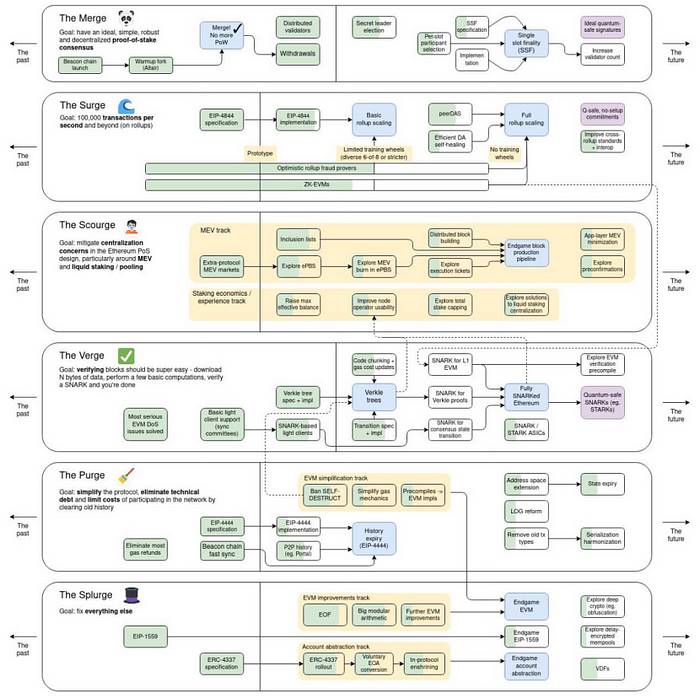Written by: Bulu

Recently, there have been many controversial voices in the industry regarding the development and current status of Ethereum. The focus of doubts is mainly on the following aspects:
Question 1: The Ethereum Foundation account frequently transfers ETH, its financial planning is not transparent, and the assets it holds may be difficult to maintain subsequent operations and development.
Related events:
learn more
On August 24, 2024, the Ethereum Foundation deposited 35,000 ETH into Kraken, and the market value of ETH fell by 13% in the following 6 days.
At 16:10 on September 5, 2024, according to the monitoring of @ai_9684xtpa, the Ethereum Foundation transferred another 100 ETH. The address has transferred a total of 2,616 ETH on the chain in the past 8 months.
At 14:07 on September 6, 2024, according to Lookonchain's monitoring, the Ethereum Foundation transferred 1,000 ETH to a multi-signature address starting with 0xbC9a 15 minutes ago. According to previous transaction patterns, this multi-signature wallet account may transfer ETH to a wallet address starting with 0xd779 and convert it into DAI assets.
Responses and Discussion:
Justin Drake of the Ethereum Foundation expressed his personal opinion at the 12th open question and answer event (hereinafter referred to as AMA) held on the Raddit platform on September 5, 2024 : The financial report of the Ethereum Foundation will be released soon. It is estimated that the Ethereum Foundation as a whole holds about 10 years of funds in reserve, and the funds reserves will change significantly due to fluctuations in the price of Ethereum.
Based on the current asset market value, the Ethereum Foundation spends about $100 million per year. The Ethereum wallet used by the Ethereum Foundation currently holds assets worth about $650 million. At the same time, the Ethereum Foundation also has currency reserves that can cover operational needs in the next few years.
Ethereum founder Vitalik Buterin said in the 12th AMA: Currently, the Ethereum Foundation's budget strategy is to spend 15% of the remaining funds each year, which means that the Ethereum Foundation can continue to operate, but its influence in the ecosystem will decrease over time.
According to media reports, Aya Miyaguchi, executive director of the Ethereum Foundation, once posted on social media: The Ethereum Foundation has an annual budget of about $100 million, which is mainly composed of grants and salaries, and some recipients can only accept legal currency payments. Since 2024, due to complex regulatory reasons, the Ethereum Foundation has been told not to conduct any funding activities and is currently unable to share plans in advance. The Ethereum Foundation's ETH transfer transactions are not sales.
Question 2: Ethereum’s roadmap planning focuses too much on Layer 2 solutions (mainly Rollups) and ignores the development and improvement of Ethereum’s mainnet Layer 1. The roadmap needs to be revised.
Responses and Discussion:
Ethereum researcher Dankrad Feist said in his personal opinion at the 12th AMA: Many people believe that the Rollups-centric roadmap will weaken Ethereum's fee income and MEV, and Rollups may eventually become parasites. I don't think this is correct.
Today, the highest value transactions will still occur on Ethereum mainnet Layer 1, and Rollups will expand the entire ecosystem by providing users with a large amount of transaction space. This relationship is symbiotic: Ethereum provides cheap data availability for Rollups, and Rollups make Ethereum Layer 1 a natural hub for high-value transactions.
In the process of advancing the Ethereum roadmap centered on Rollup, I believe that expanding the execution capabilities of Layer1 should also be a goal, which does not necessarily conflict with the roadmap , as shown in:
Data availability is almost infinitely scalable - the ultimate limit to scalability essentially comes from user interest in Ethereum, that is, how many people are willing to seriously run full nodes and record all data.
Execution capabilities are bound to be subject to objective limitations, but the ultimate limiting bottleneck is the single-thread limitation. At present, state access is a direct limitation on expanding Ethereum Layer 1 execution capabilities.
Through zkEVM and parallelization technology, the scalability of Ethereum Layer1 can be increased by 10 times to 1000 times. Rollups will provide the remaining scalability to meet Ethereum's needs for "world-class scale".
The Ethereum Foundation's long-term sustainable plan is to use SNARKs to expand the EVM execution capabilities of Ethereum Mainnet Layer 1. In addition to the vertical scaling benefits brought by significantly improving the Layer 1 EVM Gas limit, there is also the opportunity to use EVM-in-EVM precompilation for arbitrary horizontal scaling to verify EVM execution within EVM at low cost.
This precompilation will allow developers to programmatically launch new Layer1 EVM instances, unlocking a supercharged version of execution sharding where the number of shards is unlimited and a single shard is a programmable Rollup, or “native Rollup.”

△ Ethereum's 2024 roadmap consists of the following 6 parts:
The Merge, The Surge, The Scourge, The Verge, The Purge and The Splurge
Question 3: The ecosystem is developing well, but the market value of ETH has not increased significantly.
Responses and Discussion:
Anders Elowsson of the Ethereum Foundation expressed his personal opinion at the 12th AMA: In the long run, Ethereum's facilitation of sustainable economic activity is directly related to the appreciation of ETH's market value. If you design a sustainable economic activity system, you are designing ETH's price growth. Vice versa, when designing ETH appreciation, you must ensure that Ethereum facilitates sustainable economic activity.
Focusing on "price growth" in the short term without considering its source may lead to reduced value in the long term. I personally believe that the current roadmap is actually also a "price growth roadmap". If Ethereum succeeds, but ETH does not grow in price, I will be surprised and even a little disappointed, but this may be an opportunity to buy ETH because the market will eventually realize this price growth theory.
Justin Drake of the Ethereum Foundation said in the 12th AMA : I personally think that whether ETH's price will grow or not comes down to liquidity and premium. The key indicator for liquidity is the total fee, not the fee per transaction. The key indicator for premium is the proportion of ETH used as a staked asset. In the future, Ethereum's goal of success is to reach 10 million transactions per second, which can still bring billions of dollars in revenue per day even if the fee per transaction is less than 1 cent.
Question 4: The cost of Optimistic Rollups is actually cheaper than ZK Rollups. Logically, ZK is a superior technology.
Responses and Discussion:
George Kadianakis said in the 12th AMA: The Ethereum Foundation is currently researching different zero-knowledge (ZK) projects at multiple stages.
Justin Drake of the Ethereum Foundation said in the 12th AMA: I am very excited about bringing SNARKs to Layer1 EVM. We have made great progress in the past few months. According to the latest data from Uma (from Succinct), the current cost of proving all Layer1 EVM blocks is about $1 million per year, and future optimizations will further reduce this cost.
It is expected that by the 2025 period, the cost of proving all Layer1 EVM blocks could be just $100,000 per year, thanks to SNARK ASICs and optimizations at every level of the stack. The Ethereum Foundation is also accelerating formal verification of the zkEVM, a project led by Alex Hicks with a budget of $20 million.
For the Beacon Chain, our recent benchmark accelerated the timeline for converging hash-based signatures with SNARKs. This is key to achieving post-quantum security for the Beacon Chain.
Max Resnick, Ethereum researcher at the Special Mechanisms Group (SMG), said in an interview with the Bankless podcast: ZK is the only technology that can really make a breakthrough in bandwidth limitations, and Optimistic Rollups can’t do it…
What to do next? I think we should start optimizing the functionality needed for ZK Rollups.
If you want to continue with the Rollups route, you need to turn immediately to make the cost of verifying ZK proofs on the chain lower, rather than continuing to lower data costs, because the data on the chain is now almost free.
In addition, I think the fees on Ethereum Layer 1 have reached a balanced level, but if you want to launch an application, the key thing to consider is: what will the fees become when the application achieves explosive growth?
If I were an application developer and developed a killer application that could achieve 100x growth and bring in a large number of users, I would not choose to release it on Ethereum at this stage - because in the best case, if I succeed, it will clog the chain and the fees will become so high that it is unusable. So, based on this consideration, the really important development facing Ethereum now is not to maintain the current equilibrium state, but to create how strong the expansion capability can be, so strong that it can attract top application developers who want to bring 100x user growth into the Ethereum ecosystem .

How should we view Ethereum’s predicament and doubts?
Tracing back to the original intention, firmly optimistic about the value development of Ethereum
Compared with the doubts about Ethereum in the market, Ethereum founder Vitalik Buterin is still firmly optimistic about the future of Ethereum and believes that it is full of hope. At the ETHTAIPEI event in 2024, Ethereum founder Vitalik Buterin once said in a group interview with the media:
“I think the next five years will be critical for the development of Ethereum. Because before that, many applications that were still in the theoretical stage or small-scale will be ready to enter the real world from now on . Many ideas generated in the blockchain field have penetrated into the wider world in many ways that have not yet been fully recognized.
Non-financial applications are also expected to start having a greater impact . The particular benefit that decentralization brings to these projects is that almost anyone can write a new client, and when you have a new client, you can access and write the same content without having to build your network effect from scratch.
At the same time, I expect the Ethereum-based identity space to grow rapidly , the technology is improving rapidly, and I really hope that it will soon see more mainstream use cases introduced. A lot of people are worried about the issue of account identity, but currently when people want to solve it, the first thing they consider is a centralized solution. I hope that the Ethereum space can create truly decentralized identity alternatives and make them easily accessible.
In addition, Stable Coins may have a significant impact in the future, and Ethereum can help Stable Coins become more open, decentralized, and not dependent on third parties with weak trust foundations . You can already see the efforts made by Layer2 projects such as Base. "
Looking ahead, the market still needs to give Ethereum some time
1. Looking forward to Pectra upgrade
Following the Dencun upgrade, Ethereum will usher in another major technical update, the Pectra upgrade, in the first quarter of 2025. This upgrade will further simplify and improve the process of creating and maintaining on-chain smart contracts, which means that developers can develop more powerful applications more efficiently, and users can also experience faster transaction speeds, lower transaction fees, and safer on-chain use cases.
The Pectra upgrade has direct benefits for projects and users such as modular blockchains, abstract accounts, and abstract account wallets. In addition, the Pectra upgrade also includes technical improvement proposals that benefit the ZK Prover network, which is also an effort to enhance ZK technology.
2. Outlook on PoS mechanism, ecological innovation and strong community power
Whether the PoS consensus mechanism will lead to centralization risks is a concern for many blockchain users.
Ethereum founder Vitalik Buterin once said in an interview with the media: The risk of centralization of the PoS consensus mechanism is the main challenge at present. The situations that may bring centralization risks and attract more attention include the growth of MEV censorship risks and staking activities.
Compared with other influential industry figures in the blockchain world, Ethereum founder Vitalik Buterin and Ethereum's core team have always been highly vigilant about various centralized situations that have emerged on Ethereum, and have insisted on actively speaking out for the concept of decentralization. This is also the core strength of Ethereum that is worth looking forward to firmly.
In addition, although Ethereum's use case innovation and growth seem to have entered a development bottleneck period, in the world of blockchain, thanks to the continuous upgrading of Ethereum infrastructure and technological improvement, Ethereum's ecological power is still strong, and its most unique value lies in its strong community power - this is the necessary foundation for disruptive innovation, and it is also a firm support for Ethereum's future development to achieve rapid development.
4. Outlook for ZK Technology
In the Layer2 ecosystem that improves Ethereum's scalability, there is a certain consensus on the development and applicability of Optimistic Rollups and ZK Rollups: in the short term, the development of Optimistic Rollups with better compatibility will be faster than the development of the ecosystem based on ZK technology. But in the long run, ZK Rollups that can ensure the validity of real-time transactions and provide privacy protection will inevitably be more actively developed.
Privacy is the key to pushing Ethereum into a new chapter . Ethereum founder Vitalik Buterin once said in a blog post discussing the three technological transformations that Ethereum needs: If there is no excessive technological transformation of privacy, Ethereum may lose most of its users and may fail.
The privacy protection scenario provided by ZK technology is its main application scenario in the blockchain field. As Vitalik Buterin once emphasized at the Ethereum community annual meeting: "In the next 10 years, ZK-SNARK will be as important as blockchain."
As the technology matures, the narratives around ZK technology will become more diverse and attractive in the next steps of Ethereum’s development.
5. Outlook for ETH
In the second quarter partner letter published on the social platform X on August 24, 2024, Nick Tomaino, founder of 1confirmation, expressed his strong optimism about the development trend of digital assets: ETH market value may exceed BTC in the next 5 years. Currently, BTC's market value is about 4 times higher than Ethereum's market value. Both will continue to grow, but ETH will eventually surpass BTC.
It is still a relatively common consensus that the value accumulation of ETH is crucial to the success of Ethereum. As the members of the Ethereum Foundation said in the 12th AMA: the value accumulation of ETH will be achieved through total fees and asset premiums, and the value growth of ETH will support the security and economic activities of the Ethereum ecosystem, thereby promoting Ethereum to become a global financial platform.







